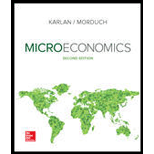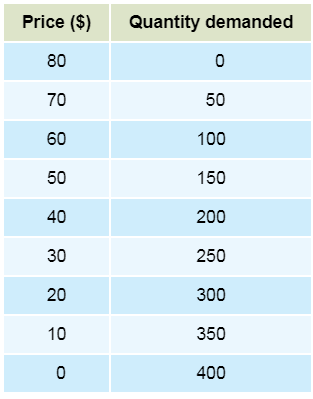
Problems 7 and 8 refer to the

Consider each of the following price increase scenarios.
- Price increases from $10 to $20. Demand is _____ and total revenue _____.
- Price increases from $30 to $40. Demand is _____ and total revenue _____.
- Price increases from $50 to $60. Demand is _____ and total revenue _____.
(a)
To fill: the given blanks with suitable answer.
Answer to Problem 7PA
The demand is "inelastic" and total revenue "increases".
Explanation of Solution
Since the negative sign shows the inverse relationship between price and demand,
TR when the price is 10 and the quantity is 350.
TR when the price is 20 and the quantity is 300.
The demand is "inelastic" and total revenue "increases".
(b)
To fill: the given blanks with suitable answer.
Answer to Problem 7PA
The demand is "inelastic" and total revenue "increases".
Explanation of Solution
Since, negative sign shows the inverse relationship between price and demand.
TR when price is 30 and quantity is 250.
TR when price is 40 and quantity is 200.
The demand is "inelastic" and total revenue "increases".
(c)
To fill: the given blanks with suitable answer.
Answer to Problem 7PA
The demand is "elastic" and total revenue "decrease".
Explanation of Solution
Since the negative sign shows the inverse relationship between price and demand. So, it should be ignored.
TR when the price is 50 and the quantity is 150.
TR when the price is 60 and the quantity is 100.
The demand is "elastic" and total revenue "decrease".
Want to see more full solutions like this?
Chapter 4 Solutions
Microeconomics
- Estimates presented in Exhibit 5 show that Android users have a higher price elasticity of demand for apps in the Google Play Store than do iPhone users in the Apple App Store. Why might Android users tend to be more sensitive to app prices than iPhone users? What categories or types of apps (for example, games/social media) do you think have the highest price elasticities?arrow_forwardOn Tuesday, the price and quantity demanded are 7 and 120 units, respectively. Ten days later, the price and quantity demanded are 6 and 150 units, respectively. What is the price elasticity of demand between the 7 and 6 prices?arrow_forwardSuppose a movie theater raises the price of popcorn 10 percent, but customers do not buy any less popcorn. What does this tell you about the price elasticity of demand? What will happen to total revenue as a result of the price increase?arrow_forward

 Economics (MindTap Course List)EconomicsISBN:9781337617383Author:Roger A. ArnoldPublisher:Cengage Learning
Economics (MindTap Course List)EconomicsISBN:9781337617383Author:Roger A. ArnoldPublisher:Cengage Learning







